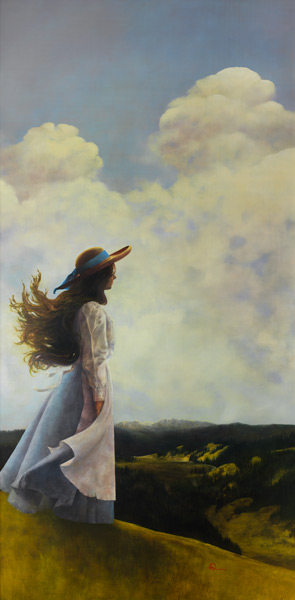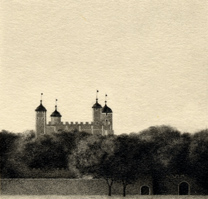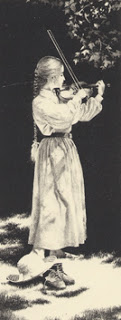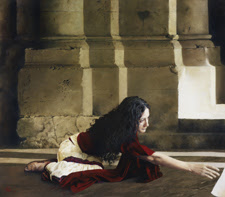What am I looking at?
By Al R. Young
 |
| High Valley by Al R. Young, 2005 |
Several years ago, a good friend visited the studio and gallery. At one point during our visit, we stood a while in the loft above the studio. Four large tonal landscape paintings, after the style of the Hudson River School, filled three of the walls like picture windows.
My guest looked from painting to painting, and, whether moved by the sheer size of the artworks or influenced by something in the treatment of the subject matter, exclaimed with evident anxiety: "I wish I knew what I was looking at!"
Like so many artists, I thought, but did not say: "I wish you did, too!"
For the first 40 years or so of my journey as an artist, I worked primarily in pencil and spent a few years on lithographs. Looking back, I have come to understand that the monochrome decades simplified the task of learning how to visually tell a story--reducing complexity much like the creation of a grisaille. The result was a well honed approach to the way I compose an image.
Each medium in which I have worked has been used to refine various skills in a stair-step progression to oils. From pencil drawings to lithography and then to oils, the thread of that striving is evident. Consequently, I doubt that my paintings can be fully understood or appreciated without consulting the pencil drawings and lithographs that preceded them. And while various skills were being developed during those years, I did the same thing a writer does, who lives a while before discovering his own voice, and then goes on to discover what he is supposed to say with it.
Like so many artists, I thought, but did not say: "I wish you did, too!"
For the first 40 years or so of my journey as an artist, I worked primarily in pencil and spent a few years on lithographs. Looking back, I have come to understand that the monochrome decades simplified the task of learning how to visually tell a story--reducing complexity much like the creation of a grisaille. The result was a well honed approach to the way I compose an image.
 |
| The Tower of London by Al R. Young, 1986 |
 |
|
In the Clearing by Al R. Young, 1998 |
In each painting, I strive to create an image that helps viewers liken the scriptures to their own lives. Consequently, re-creating scriptural incidents or something like a photograph of scriptural characters is not the objective. Instead, I work to create intensely personal, visual metaphors to scriptural themes, whereby viewers can empathize with a character and bring the resulting insight and encouragement to bear upon the circumstances and choices of their own lives.
To the best of my ability, every aspect of my religious artwork focuses on this overriding purpose. This requires a reconciling or balancing of contemporary and ever-changing ideas (about such things as "accuracy" and "authenticity," for example) with the greater need to touch the hearts and minds of viewers.
The aim is to actually transcend barriers of culture, time, and place; not to re-create them. Consequently, such considerations as the focus of the composition; the number of figures included; lighting; size and dimensions of the work; costuming, material culture, and other aspects of "historical re-creation;" etc., all serve the greater aim of making it possible for viewers to liken the scriptures to self.
Research plays an important part in creating every artwork; nevertheless, I am reminded of something Arnold Friberg once said: Research is only a tool and a servant of truth. It is an aberration of our time that this magic word research has been inflated out of proportion until it is mistaken for the thing itself. No amount of provable historical fact can ever bring forth a work of art that will move and strike fire into the hearts of men. -- "The Prayer at Valley Forge," Arnold Friberg. Ensign Magazine vol. 3 no. 2 (Salt Lake City: The Church of Jesus Christ of Latter-day Saints, February 1973), center fold (insert)
Tags: In the Clearing, In The High Valley, I Shall Be Whole, 2012, Costume and props, Inspiration and creativity, Tips and techniques
Browse articles by year: 2025 . 2024 . 2023 . 2022 . 2021 . 2020 . 2019 . 2018 . 2017 . 2016 . 2015 . 2014 . 2013 . 2012 . 2011 . 2010 . 2009 . 2008 . 2007 . 2006 . 2005 . 2004 . 2003 . 2002 . 2001 . 2000 . 1999 . 1998 . 1997 . 1996
Browse articles by topic: Art lessons . BenHaven Archives . Blank art diaries . Fine art photography . Framing . Illustration . Inspiration and creativity . Isles of Rune . Limited Editions Collection . My Fathers Captivity . News . Novellas . Oil paintings and prints . Operations announcements . Orders and shipping . Overview . Portfolios . The Papers of Seymore Wainscott . Project commentaries . Recipes by Nancy Young . Recommended reading . Recommended viewing . Temple artworks . The Storybook Home Journal . Tips and techniques . Tools supplies and operations
Browse articles by topic: Art lessons . BenHaven Archives . Blank art diaries . Fine art photography . Framing . Illustration . Inspiration and creativity . Isles of Rune . Limited Editions Collection . My Fathers Captivity . News . Novellas . Oil paintings and prints . Operations announcements . Orders and shipping . Overview . Portfolios . The Papers of Seymore Wainscott . Project commentaries . Recipes by Nancy Young . Recommended reading . Recommended viewing . Temple artworks . The Storybook Home Journal . Tips and techniques . Tools supplies and operations
